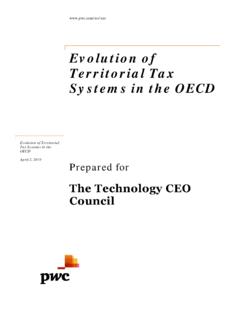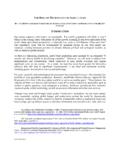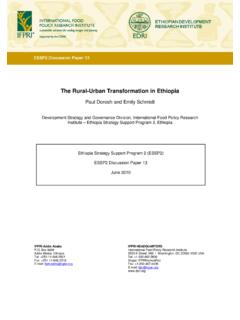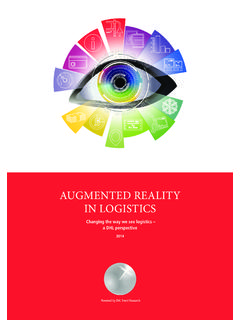Transcription of THE COMING PRODUCTIVITY BOOM - Technology …
1 Michael MandelBret SwansonTHE COMING PRODUCTIVITY BOOMT ransforming the Physical Economy with InformationMarch 2017 THE COMING PRODUCTIVITY boom Transforming the Physical Economy with InformationCONTENTSFOREWORD: Driving a PRODUCTIVITY boom that Benefits All Americans .. page 1 EXECUTIVE SUMMARY ..page 2 THE COMING PRODUCTIVITY boom : Transforming the Physical Economy with 4 PREVAILING VIEWS ON PRODUCTIVITY ..page 8 DEFINING THE DIGITAL VERSUS PHYSICAL 9 MAKING THE PHYSICAL ECONOMY PRODUCTIVE 10 Personal 10 Energy 12 Education and 13 Retail, Wholesale, and Distribution ..page 14 Manufacturing and the New IT Revolution ..page 18 OPTIMISTIC SIGNS IN THE 22 PROJECTING THE ECONOMIC 24 THE FUTURE OF JOB 25 PUBLIC POLICY ..page 26 Empowered People ..page 26 Innovation 27 Entrepreneurial Business Climate ..page 28 CONCLUSION .. page 30 APPENDIX: Projecting the Potential PRODUCTIVITY Gains from the New IT 31 NOTES for Prevailing Views on PRODUCTIVITY on page 35 COMING PRODUCTIVITY BOOMA bout the AuthorsMICHAEL MANDEL, , is chief economic strategist at the Progressive Policy Institute.
2 He is also president of South Mountain Economics and a senior fellow at Wharton s Mack Institute for Innovation Management at the University of Pennsylvania. Mandel was previously the chief economist at SWANSON is president of the Technology research firm Entropy Economics LLC. He is also a visiting fellow at the American Enterprise Institute s Center for Internet, Communica-tions, and Technology Policy, a scholar at the Chamber of Commerce Foundation, and vice chairman of the Indiana Public Retirement System (INPRS).The Technology CEO Council is the public policy advocacy organization comprising Chief Executive Officers from America s leading information Technology companies, including Akamai, Dell, IBM, Intel, Micron, Oracle, Qualcomm and Xerox. PRODUCTIVITY boom page 1It is amazing how many of our nation s biggest challenges can be addressed by a simple formula: faster growth more broadly shared. From infrastructure to healthcare, edu-cation to national security, crime to creativity, a bigger pie and a wider winner s circle go far towards solving them.
3 A simple comparison of potential growth rates tells the story. At the current expected growth rate of 2% annually, the country will struggle to meet its obligations and invest in the future. But if growth accelerates to annually, as this paper s analysts project, it will add a cumulative $ trillion in wages and salaries over the next 15 years (measured in 2016 dollars). And while Americans will have more to spend on meeting their needs, the government will have more funding to help out. Federal reve-nues will go up by an added $ trillion without any increase in federal taxes as a share of GDP. Some of that will go to cutting the debt, while still leaving additional revenue for other needs, such as infrastructure and security. (These figures are based on projections and analysis developed in this paper.)Unfortunately, over the past few decades the pace of economic growth around the world has slowed. Whereas economic growth averaged in the 1980s and in the 1990s, it fell to just in the 2000s and only so far this decade.
4 At the same time in more developed economies such as the United States, this more-slowly-rising tide has lifted fewer boats than in the past. The result? Frus-tration, pessimism, can do output is the product of two factors: total hours worked times PRODUCTIVITY of the workforce. Growth occurs when these factors increase, yet over the past decades both have slowed. To reignite economic growth, we need to accelerate either the size of our workforce or its PRODUCTIVITY . And since simple demograph-ics limits the growth of our workforce, the great American economic imperative is to accelerate productivit is good news. With the arrival of powerful new technologies, we stand on the verge of a PRODUCTIVITY boom . Just as network-ing computers accelerated PRODUCTIVITY and growth in the 1990s, innovations in mobility, sensors, analytics, and artificial intelligence promise to quicken the pace of growth and create myriad new opportunities for innovators, entrepreneurs, and Technology CEO Council commis-sioned this analysis to better understand how new technologies can catalyze growth and what policy makers can do to accelerate these positive trends while making sure their benefits are realized by more Americans.
5 We believe smart public policies will hasten the diffusion of these technologies and enable innovation, entrepreneurship and growth. Policy innova-tions are likewise critical to maximizing the number of citizens able to reap the rewards of these extraordinary all the challenges facing our nation and our world, solutions exist. Many will require tough choices and hard work, but the oppor-tunities are there. We are most excited to lead innovative organizations creating many of these emerging solutions, and we are quite eager to assist with policy makers around the world working to bring them to Technology CEO CouncilForewordDriving a PRODUCTIVITY boom that Benefits All AmericansThere is good news. With the arrival of powerful new technologies, we stand on the verge of a PRODUCTIVITY PRODUCTIVITY boom page 2 Executive SummaryThe Information Age is not over. It has barely begun. The diffusion of information Technology into the physical industries is poised to revive the economy, create jobs, and boost incomes.
6 Far from nearing its end, the Information Age may give us its most powerful and wide-spread economic benefits in the years ahead. Aided by improved public policy focused on innovation, we project a significant accel-eration of PRODUCTIVITY across a wide array of industries, leading to more broad-based economic growth. The 10-year PRODUCTIVITY drought is almost over. The next waves of the information revo-lution where we connect the physical world and infuse it with intelligence are beginning to emerge. Increased use of mobile technolo-gies, cloud services, artificial intelligence, big data, inexpensive and ubiquitous sensors, computer vision, virtual reality, robotics, 3D additive manufacturing, and a new gen-eration of 5G wireless are on the verge of transforming the traditional physical indus-tries healthcare, transportation, energy, education, manufacturing, agriculture, retail, and urban travel services. At , PRODUCTIVITY growth in the digital industries over the last 15 years has been strong.
7 On the other hand, PRODUCTIVITY in the physical industries grew just annually, leading to anemic economic growth over the last decade. The digital industries, which account for around 25% of private-sector employ-ment and 30% of private-sector GDP, make 70% of all private-sector investments in information Technology . The physical industries, which are 75% of private-sector employment and 70% of private-sector GDP, make just 30% of the investments in infor-mation Technology . This information gap is a key source of recent economic stagnation and the produc-tivity paradox, where many workers seem not to have benefited from apparent rapid technological advances. Three-quarters of the private sector the physical economy is operating well below its potential, dragging down growth and capping living standards. In particular, the crucial manufacturing sector, outside the computer and electron-ics industry, has barely boosted its capital stock of IT equipment and software over the past 15 years.
8 Not surprisingly, PRODUCTIVITY growth in manufacturing has slowed to a crawl in recent years. Information technologies make existing processes more efficient. More impor-tantly, however, creative deployment of IT empowers entirely new business models and processes, new products, services, and platforms. It promotes more competitive differentiation. The digital industries have embraced and benefited from scalable plat-forms, such as the Web and the smartphone, which sparked additional entrepreneurial explosions of variety and experimentation. The physical industries, by and large, have not. They have deployed comparatively little IT, and where they have done so, it has been focused on efficiency, not innovation and new scalable platforms. That s about to change. Healthcare, energy, and transportation, for example, are evolving into information indus-tries. Smartphones and wearable devices will make healthcare delivery and data collection more effective and personal, while computa-tional bioscience and customized molecular medicine will radically improve drug discov-ery and effectiveness.
9 Artificial intelligence will assist doctors, and robots will increas-ingly be used for surgery and eldercare. The boom in American shale petroleum is largely an information Technology phenomenon, and it s just the beginning. Autonomous vehicles and smart traffic systems, mean-while, will radically improve personal, public, and freight transportation in terms of both efficiency and safety, but they also will create new platforms upon which entirely new economic goods can be PRODUCTIVITY boom page 3 Manufacturing may be on the cusp of transformation not just by robotics and 3D printing, but by the emergence of smart manufacturing more broadly: a fundamen-tal rethinking of the production and design processes that substantially boost produc-tivity and demand. That, in turn, could create a new set of manufacturing-related jobs and allow American factories to compete more effectively against low-wage rivals. Far from a jobless future, a more produc-tive physical economy will make American workers more valuable and employable.
10 It also will free up resources to spend on new types of goods and services. Artificial intelligence and robots will not only perform many unpleasant and super-human tasks but also will complement our most human capa-bilities and make workers more productive than ever. Humans equipped with boundless information, machine intelligence, and robot strength will create many new types of jobs. Employment growth in the digital sector has modestly outpaced employment growth in the physical sector, despite the big edge in PRODUCTIVITY growth for digital industries. This suggests that we can both achieve higher living standards and create good new jobs. The notion that automation is the key enemy of jobs is wrong. Over the medium and long terms, PRODUCTIVITY is good for employment. How much could these IT-related invest-ments add to economic growth? Our assessment, based on an analysis of recent history, suggests this transforma-tion could boost annual economic growth by percentage points over the next 15 years.






